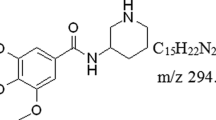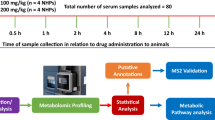Abstract
In vivo 19F-NMR spectroscopy has been used to study the pharmacokinetics of the experimental antifolate drug CB3988 (C2-desamino-C2-methyl-N10-propargyl-2'trifluoromethyl-5,8-dideazafolic acid) in mice and rats. NMR results have been compared to those obtained by HPLC and the effect of the inclusion of the CF3 group evaluated by comparing the pharmacokinetics of CB3988 and ICI 198583 (C2-desamino-C2-methyl-N10-propargyl-5,8-dideazafolic acid) in rats. In mice, following the administration of CB3988 (500 mg kg-1 i.v.), drug could be detected in both the upper and the lower abdomen. NMR signal from the upper abdomen reached maximum intensity 10-40 min after administration, declining thereafter with a half life of 28 min. Signal detected in the lower abdomen reached maximum intensity 60-90 min after treatment. HPLC analyses indicated that CB3988 was present at appreciable concentrations (about 20-30 mg ml-1) in both bile and urine which is consistent with the signal from the upper and lower abdomen being derived from the gall bladder and urinary bladder, respectively. Studies in rats also indicated that CB3988 (100 mg kg-1 i.v.) rapidly entered and was cleared from the upper abdomen. Comparison of data from rats with intact and cannulated bile ducts suggested that 19F-NMR could detect CB3988 undergoing enterohepatic circulation. Furthermore, comparison of the plasma half life of CB3988 with the half life for the decline of the NMR signal from the upper abdomen suggested that NMR measurements may reflect the plasma clearance of CB3988. When the pharmacokinetics of CB3988 and ICI 198583 were compared the only significant difference was in the alpha phase half life which was 2-fold faster for CB3988. These data demonstrate that CB3988 is cleared rapidly by both biliary and urinary excretion. This is in contrast to N10-propargyl-5,8-dideazafolic acid, where delayed excretion is associated with hepatic and renal toxicities. The ability to study CB3988 pharmacokinetics non-invasively by 19F-NMR spectroscopy confirms the utility of the technique and, since 19F-NMR can be applied directly to clinical investigations, it may be possible to obtain similar information in humans.
This is a preview of subscription content, access via your institution
Access options
Subscribe to this journal
Receive 24 print issues and online access
$259.00 per year
only $10.79 per issue
Buy this article
- Purchase on Springer Link
- Instant access to full article PDF
Prices may be subject to local taxes which are calculated during checkout
Similar content being viewed by others
Author information
Authors and Affiliations
Rights and permissions
About this article
Cite this article
Newell, D., Maxwell, R., Bisset, G. et al. Pharmacokinetic studies with the antifolate C2-desamino-C2-methyl-N10-propargyl-2'-trifluoromethyl-5,8-dideazafolic acid (CB3988) in mice and rats using in vivo 19F-NMR spectroscopy. Br J Cancer 62, 766–772 (1990). https://doi.org/10.1038/bjc.1990.376
Issue Date:
DOI: https://doi.org/10.1038/bjc.1990.376
This article is cited by
-
The pharmacokinetics of the quinazoline antifolate ICID 1694 in mice and rats
Cancer Chemotherapy and Pharmacology (1991)



